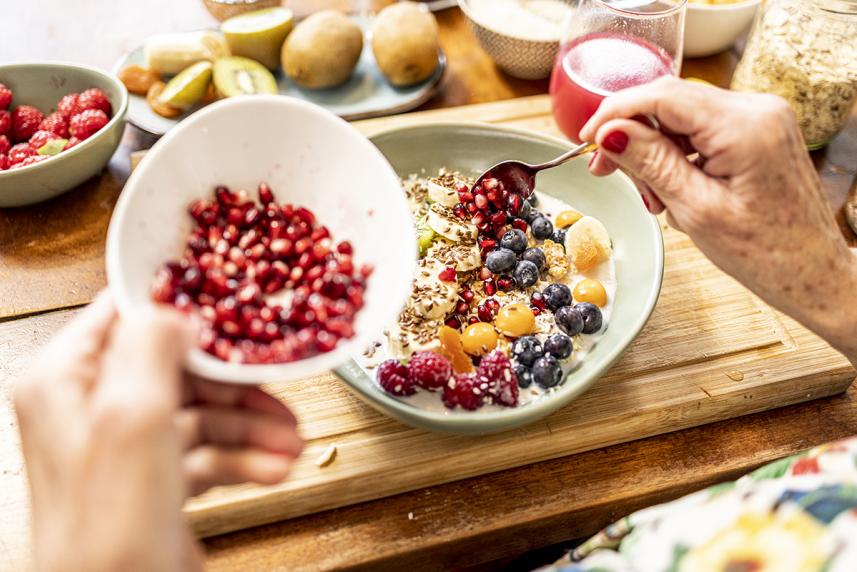Five eating habits that can help keep your blood sugar in check
Preventing diabetes doesn’t require overhauling your whole diet. Start with these five simple but high-impact changes.

If you have a family history of diabetes or you’ve been diagnosed with prediabetes, you know how important it is to keep your blood sugar in check. You probably also know that what you eat can have a big impact on your blood sugar.
What might be less clear is how you should eat to manage your blood sugar. Should you follow a low-carb diet? A low-fat diet? A Mediterranean diet? Those could all benefit your health, but the truth is that you don’t need to follow a strict diet.
Making just a few small but mighty eating changes can add up to big improvements for your health, says Lorena Alarcon-Casas Wright, M.D. She’s the director of the LatinX Diabetes Clinic at the University of Washington School of Medicine.
Here’s a look at five habits that can help you do just that.
Make water your go-to drink
Drinking more water is linked to a lower risk of type 2 diabetes. Why? For starters, water is naturally calorie-free. So choosing it over a sugary drink such as soda, sweet tea, or juice can help you lose excess weight. And that’s one of the best things a person can do to lower their diabetes risk, says Dr. Wright.
Water doesn’t have any sugar either. So if you replace sugary drinks with water, you’ll make huge strides toward slashing your added sugar intake. You can start small — if you usually grab a soda when you feel thirsty, try drinking a glass of water first. It might lead you to drink less soda.
Add more fiber-rich foods
Fact: 9 out of 10 U.S. adults don’t eat enough fiber, according to the U.S. Department of Agriculture. But adding more fiber to your meals and snacks can go a long way toward managing your blood sugar. Unlike other types of carbs, fiber won’t raise your blood sugar as much. And it can slow down digestion and absorption of other carbs. That leads to a more gradual blood sugar rise, rather than a sharp spike and crash.
For example: Pairing fiber-rich beans with rice can lead to a slower rise in blood sugar post-meal than if you ate just rice alone. Fiber-rich meals can also keep you fuller longer, which may help you lose weight or maintain it.
The Centers for Disease Control and Prevention recommends 22 to 34 grams of fiber daily, depending on your age and sex. High-fiber foods such as whole grains, beans, fruits, vegetables, nuts, and seeds will help you hit the mark. Here’s what that might look like in a day:
- 1 cup oatmeal: 4 grams
- 1 medium apple: 4 grams
- A sandwich made with two slices whole-wheat bread and half an avocado: 10 grams
- 1 cup steamed broccoli: 4 grams
- 1 cup pinto beans and brown rice: 10 grams
Set up some sugar ground rules
You don’t have to give up dessert entirely to manage your blood sugar. But it’s a good idea to be smart about sugar. Sweet foods such as cookies, cake, or candy cause your blood sugar to rise and fall quickly. That can up your diabetes risk over time.
Setting some sugar ground rules can stave off those spikes. First, always eat dessert with a meal instead of by itself. “Having a treat with a meal that contains protein lessens the blood sugar spike,” says Angela Ginn-Meadow, R.D. She’s a Baltimore-based diabetes educator.
Second, try to take a walk within 15 to 30 minutes after you eat. Your muscles will use up some of the sugar from your dessert as fuel. And that can help keep your blood sugar levels lower.
Fill half your plate with veggies
It’s an easy rule of thumb for building diabetes-friendly meals. Vegetables are packed with fiber and good-for-you nutrients, but they’re low in calories and carbs, so they can keep your weight in check. They’ll also fill you up without spiking your blood sugar.
You’ll reap the biggest benefits from non-starchy veggies. Think leafy greens, broccoli, peppers, mushrooms, artichokes, celery, cucumber, eggplant, cauliflower, onions, tomato, or zucchini. Starchier vegetables such as potatoes, corn, or sweet potatoes are higher in carbs and have a bigger blood sugar effect. They’re still good for you, but it’s better to count them as a carb food.
As for the rest of your plate, fill one-fourth with lean protein such as chicken, fish, eggs, or tofu. Fill the last fourth with carb foods such as starchy vegetables, fruit, beans, and grains or grain products (such as bread, pasta, and tortillas). Limiting carb foods to just one-fourth of your plate is an easy way to keep your carb count in check at each meal.
Go big on breakfast
Research shows that regularly skipping breakfast can up your risk for diabetes by as much as 55%. That’s because going for long stretches without eating can drive up your blood sugar, explains Ginn-Meadow.
Your go-to morning meal should have fiber-rich carbs, protein, and some healthy fat. Not only will that combo keep your blood sugar steady, but it’ll also help keep you full until lunchtime. Here are some quick and easy blood sugar-friendly ideas to get you started:
- Make a breakfast taco with scrambled eggs, sauteed spinach, and mashed avocado in a whole-wheat tortilla.
- Top plain Greek yogurt with frozen fruit and nuts (let the fruit thaw a bit before eating).
- Make PB&J oatmeal: Stir peanut butter and your favorite jam into a warm bowl of oatmeal.
- Need to eat and run? A peanut butter and banana sandwich on whole wheat toast is quick to make and easy to eat on the go.
You don’t have to make these changes all at once. The key to building lifelong healthy habits is to make changes slowly and gradually. Start with one thing. Once you have that down, add more. Before you know it, you’ll be making healthy choices without even having to think about it!


